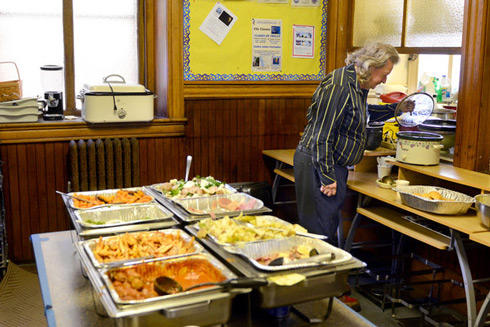An Article Published by Alfred Lubrano, Inquirer Staff Writer.
March 16, 2014. Photo courtesy of Tom Gralish/Staff Photographer
Famous for its $4.95 chocolate bars and high-end lattes, the Lambertville Trading Co. coffee bar had a line snaking out the door in Lambertville, N.J., last week, a short walk east across the Delaware River from New Hope, Bucks County.
Just yards away from the coffeehouse on Bridge Street, another line formed outside the Lambertville Food Pantry, where low-income people from both river towns waited to select donated bread, rice, and meat.
The disparate queues demonstrate the growing gap between those who live well and those who struggle in this bucolic spot long known as Philadelphia’s country getaway place.
For most people, the New Hope-Lambertville area conjures images of civilized sojourns to antiques shops, galleries, and fine-dining establishments. On spring and summer evenings, rowdy revelers party like they invented Saturday night.
But poverty rates are rising like the Delaware in a storm. And even tourist towns featuring historic canals and luxurious bed-and-breakfasts are not immune to the ubiquity of hard, basic need.
“We have everything: incredible wealth and incredible poverty,” said Linda Meacham, executive director of Fisherman’s Mark, a Lambertville social-service agency that also helps residents of New Hope, which is devoid of such facilities. The towns are so small – 3,900 live in Lambertville, 2,500 in New Hope – that definitive U.S. Census numbers on poverty rates are unavailable.
“They’re cute little towns – not Camden. People who visit don’t see the poverty, especially among the Latino immigrants and the elderly. But we do.”
Dreams and Real Life
Beneath the stained-glass windows at Centenary United Methodist Church, 40 people, many of them white and low-income, were eating a free lunch amid St. Patrick’s Day decor.
Retired Lambertville librarian Lynda Hope, 68, lamented the distance between dreams and real life:
“When I was young, I didn’t picture my husband passing away and my kids moving in on me. I dreamed I’d travel.”
Now, Hope, who gets Social Security, partakes of the weekly church lunch when she can. “This meal helps,” said Hope, who supports her two grandchildren, as well as her daughter and son-in-law, who can’t find work.
Others at the lunch talked of life in the past tense, as though the best had already occurred, and what was happening now was too tough to bear.
“Everything I love is here, but it’s one of the most expensive places in the country,” said Judy Smith, 68, who works for a social-services agency. “Some days, I’ve only been able to afford peanut butter and jelly for dinner.”
Clyde Logue, 71, said few can manage the stress of living on a fixed income as prices rise. A retired tree trimmer from the area, Logue pools his meager money with his two brothers, roommates in a farmhouse. “This is a hard time,” he said, his arm and forefinger extended, as though pointing to all of life.
Attendance Doubles
Church pastor Anna Gillette said the number of people attending the meals had doubled since the federal government cut food stamps by $5 billion nationwide on Nov. 1.
“When I tell people it’s New Hope and Lambertville people coming here in need, they’re shocked,” she said. “Homes are so expensive, and families are all moving in together.”
What develops is a have/have-not divide, Gillette said. “There’s a greater sense of inequality here – of us and them.
“It’s all so incongruous here: all the expensive restaurants and the poor.”
Food preoccupies people in New Hope and Lambertville, either for its abundance or its lack.
Restaurants are star attractions, especially now, during Restaurant Week, when 29 eateries in both towns entice diners from Philadelphia and New York with lower prices.
In a little-discussed irony, the Guatemalans and Mexicans who work in the kitchens to help maintain fine-dining restaurants on both sides of the river can’t afford the food they need, Gillette said.
Some of their provisions come from the food pantry on Bridge Street, or from one set up at Fisherman’s Mark. There are no pantries in New Hope. To help New Hope people fearful of the stigma of patronizing Lambertville pantries, Fisherman’s Markexecutives order bags with supermarket logos on them so clients can walk across the bridge looking as though they have been shopping.
“More and more Latino people who work in the restaurants, the beds-and-breakfasts, and in landscaping keep coming here,” said Joe McGrath, a former IT executive who runs the Lambertville Food Pantry. “It’s burgeoned over the last three years – up 35 percent.”
Supplying the pantries and the fussiest kitchens are local farmers, several within five miles.
 Volunteer Supply
Volunteer Supply
To get farm food to pantries and home-less shelters, Cathy Snyder, 57, of nearby Lumberville, Bucks County, founded the all-volunteer Rolling Harvest Food Rescue.
Raised in Haddonfield, Snyder worked for years in national broadcast sales. She moved to the New Hope area, saw the poverty others ignore, and inserted herself into the food chain.
Now, during growing season, Snyder rumbles down country roads in her donated 2012 Chevy Express delivery van, singing Aretha Franklin and Beatles tunes, hauling apples, kale, and anything else.
“Cathy!” everyone who sees her screams, hugging the self-described “ultraliberal, bleeding-heart, hippie vegetarian” who helps keep the poor alive in the tony river towns.
“We simply create the logistics to go from farmers to people who need the food,” Snyder said.
Last week, she checked in with Amanda Midkiff, 24, assistant manager of the Roots to River Farm outside New Hope.
Midkiff said she felt separated from the community to which the farm donates. But Snyder’s visits, even in late winter, buoy her. “I love hearing how we’re contributing to people,” she said. “It’s isolated here, but the warm fuzzies get you through.”
Then, before returning to her work, Midkiff added, “Ignoring the hungry is not sustainable. We want to help nourish this community.”



